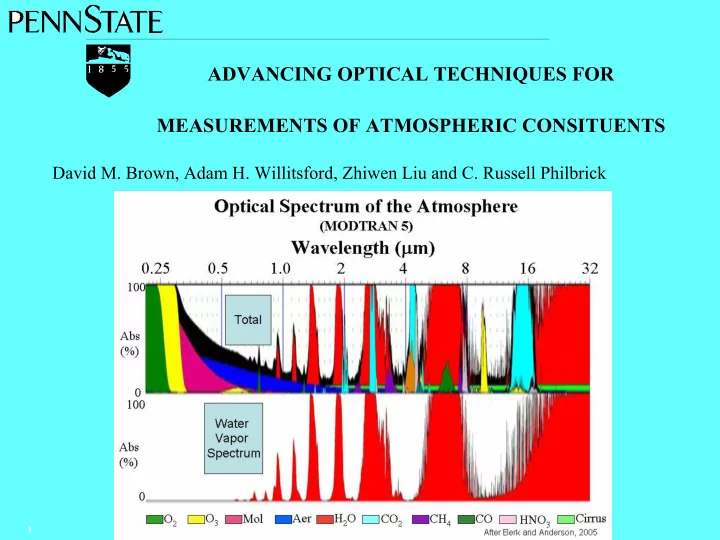

ADVANCING OPTICAL TECHNIQUES FOR MEASUREMENTS OF ATMOSPHERIC CONSITUENTS David M. Brown, Adam H. Willitsford, Zhiwen Liu and C. Russell Philbrick 1
Outline • Supercontinuum White Light Laser – Spectrum of Laser – Application to Remote Detection (DAS) of Water Vapor • MODTRAN TM 4 and MODTRAN TM 5 • Measurements of Trace constituents – Feasibility MWIR-LWIR • Carbon Monoxide • PNNL Database comparison – Nitrogen Oxides • MODTRAN TM 5 comparison – Nitrous Oxide – Example ITT Airborne Lidar
Supercontinuum White Light Laser Photonic crystal fiber • (Above) Far field pattern of the white light laser generated in a photonic (From http://www.crystal-fibre.com) crystal fiber • (Below) The rainbow observed after • Water Vapor Example the collimated white light passes through a prism • Extended to minor species monitoring O3, CO, N20 etc.
White Light Laser Spectrum • Power output of White Light Laser versus wavelength
RH 37.2+0.5 % Psychrometer 37%
IR Spectra depends upon masses of atoms, bond type and bond strength Atmospheric transmission windows in the IR spectrum
Radiance Observed Looking Down at Noon from 500 m Altitude Solar Radiation Backscatter Thermal IR of Earth Emission
Applications: Production and Pollutant Monitoring • Carbon Oxides – Monitor Power Companies • Good measure of energy production and use • Nitrogen Oxides – Internal combustion engine use and efficiency – Small scale Lidar system for engine exhaust characterization
Detection of Carbon Monoxide
PNNL Infrared Spectral Data Base
Detection of Nitrous Oxide MODTRAN TM 5 downlooking radiance of Nitrous Oxide
Integrated Atmospheric Absorption from MODTRAN TM 5
ITT - ANGEL System First Commercial DIAL Lidar C. Grund, S. Shald and S. Stearns, SPIE Proc 5412 , 2004. Murdock and Stearns, NYS Remote Sensing Sym, May 2005
ITT’s ANGEL Service Aircraft: Computer controlled pointing, scanning and tracking system Steven V. Stearns, R. Todd Lines, Darryl G. Murdock, Matthew C. Severski, Dawn D. Lenz, David M. Brown, C. Russell Philbrick
Conclusions High Resolution of MODTRAN TM 5 (0.1wavenumber) now makes it • possible to resolve minor atmospheric constituents and simulate the atmospheric influence with realistic line widths. The capability is particularly important in the design of lidar measurement scenarios. • Coupling white light differential analysis (DAS) and high resolution MODTRAN TM 5 allows measurements of trace species in the atmosphere – an initial example of a water vapor band is presented. • Utilizing the mid-infrared spectrum (3 µ m-5 µ m) along with MODTRAN TM 5 it is possible to detect and quantify trace constituents in the atmosphere (Nitrous Oxide, Methane, Sulfur Dioxide, etc.)
References • A. Berk et al., “MODTRAN5: A reformulated atmospheric band model with auxiliary species and practical multiple scattering options,” in Algorithms and Technologies for Multispectral, Hyperspectral, and Ultraspectral Imagery X, Proceedings of SPIE, v. 5425, S. Shen, ed., pp. 341 – 347, 2004. • S. Stearns, R. Lines, D. Murdock, M. Severski, D. Lenz, D. Brown, c.R. Philbrick. "Airborne Natural Gas Emission Lidar(ANGEL) System," Proceedings of the International Symposium on Spectral Sensing Research (ISSSR), 2006 • C.R. Philbrick, Z. Liu, H. Hallen, D. Brown, A. Willitsford. "Lidar Techniques Applied To Remote Detection of Chemical Species in the Atmosphere," Proceedings of the International Symposium on Spectral Sensing Research (ISSSR), 2006 • S. Stearns, T. Gigliotti, D. Murdock, "Airborne DIAL (Differential Absorption Lidar) for Broad Area Hazardous Liquid Leak Detection," Proceedings of IPC 2006
Acknowledgements • Many thanks to Kebin Shi (PSU) and Joe Begnoché (PSU) for the White Light Laser Measurements. Also thanks to ITT’s remote sensing division (Steven V. Stearns, R. Todd Lines, Darryl G. Murdock, Matthew C. Severski, Dawn D. Lenz). Thanks to PNNL data web resource (Steve Sharpe). Thanks to Gail Anderson, Jim Chetwynd and Michael Hoke for their work and assistance with Modtran TM 5.
Recommend
More recommend